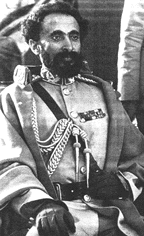Haile Selassie I, Part 2
His Imperial Majesty around the time of the Italian Invasion of 1935
 Ever since the crushing defeat of the Italian Army at Adowa in 1896,Italian officials, especially colonial officials had chaffed at thelack of revenge, or restoration of their honor. Revenge for Adowa wasconsidered essential for Italian prestige in Europe. Italian coloniesin Libya, Italian (southern) Somaliland and Eritrea were unprofitable,and in the case of Libya, unstable. The Italians increasingly sawEthiopia as their natural hinterland for their Somaliland and Eritreancolonies. A vast territory of industrious people, fertile soil,untapped mineral wealth and the prestige of ancient empire were a prizethat they were simply unwilling to pass up for good. The fact thatrelations between Ethiopia and Italy had been outwardly warm since thewar of 1896 was no deterrent. As Crown Prince and Regent, the Emperorhad visited Rome in 1923 and met with King Victor Emmanuelle and QueenHelena, as well as Italy's brand new Premier, a vulgar braggart anddemagogue named Benito Mussolini. During the visit of Prince RegentTafari, the leader of the Socialists in the Italian Parliament, and avocal opponent to Mussolini's fascism, mysteriously disappeared. Aracist cartoon in a Rome Daily depicted the Ethiopian Prince asking elDuce if he had eaten his opponent, as if that was typical behavior forEthiopian leaders to eat their enemies. The Italian and Ethiopiangovernments renewed the treaty of Friendship and Commerce, and the Kingof Italy decorated the Prince with the Order of the Annunziata,entitling him to be called a "cousin" of the King of Italy. The Princeof Udine (later made king of the fascist puppet state in Croatia), anactual cousin of the King of Italy had even attended the Emperor'scoronation in 1930. At the same time, the new fascist government waslaying down plans for the eventual conquest of the Ethiopian Empire.The excuse that Italy needed was provided by the infamous Wal Walincident and the un-demarcated border between Ethiopia and ItalianSomaliland. Wal Wal was a outpost in the Ogaden desert that had wellsused by the Somali nomads that freely crossed between British, Frenchand Italian Somalilands, and the Ethiopian Ogaden. The treaty that setdown the border between Italian Somaliland and Ethiopia stated that theborder ran parallel to the Benadir coast of Somalia at a distance of 21leagues. What was unstated was if this meant 21 standard leagues or 21nautical leagues. The Italians insisted on the nautical leagues, asthis would push the border further inland, while the Ethiopiansmaintained it was absurd to claim that the treaty used nautical leaguesto measure a distance on dry land. Nevertheless, a contingent ofItalian soldiers occupied the wells at Wal Wal and built a small forton what Ethiopia claimed was clearly Ethiopian territory, and had beenadministered by the Ethiopians. Ethiopian territorial troops under thecommand of Fitawrarri Shiferaw (posthumously created aDejazmatch)confronted the Italians, and after repeated requests for theItalians to leave the site, gunfire was exchanged. The fighting grewfierce and Italian airplanes bombed Ethiopian positions. Ethiopiacomplained to the League of Nations, calling on the collective securityagreements imbodied in the charter to be invoked and applied. TheItalians railed that it was Ethiopia that had attacked an Italianfortification. The Emperor assumed that the League would protect allmembers from aggression once the victim party was ascertained. In orderto leave no doubt as to who was the aggressor, and in a move thatshowed exactly how much faith he had put in the League, the Emperorordered all Ethiopian forces to withdraw from large areas along theborders with Italian Somaliland and Eritrea. In the meantime, Italycharged that its honor had been impinged. Ethiopia was depicted at theLeague as a savage and barbarous land where slavery and brutality werethe common way of life, a land that did not deserve to be treatedequally with "civilized countries". Ethiopia was urged to find a way toaccommodate the "civilizing influence" of Italy territorially in theOgaden and even in Tigrai in the north. The Ethiopian governmentrefused all such urgings as impinging on it's sovreignity. In November1935, thousands of Italian troops accompanied by even more nativecolonial "Askari" troops crossed into Tigrai from Eritrea in the northunder the command of Feild Marshal De Bono, an elderly and cautiousofficer who planned to progress slowly into the Empire. They werequickly followed by similar forces from Italian Somaliland in the southand east commanded by Marshal Graziani.
Ever since the crushing defeat of the Italian Army at Adowa in 1896,Italian officials, especially colonial officials had chaffed at thelack of revenge, or restoration of their honor. Revenge for Adowa wasconsidered essential for Italian prestige in Europe. Italian coloniesin Libya, Italian (southern) Somaliland and Eritrea were unprofitable,and in the case of Libya, unstable. The Italians increasingly sawEthiopia as their natural hinterland for their Somaliland and Eritreancolonies. A vast territory of industrious people, fertile soil,untapped mineral wealth and the prestige of ancient empire were a prizethat they were simply unwilling to pass up for good. The fact thatrelations between Ethiopia and Italy had been outwardly warm since thewar of 1896 was no deterrent. As Crown Prince and Regent, the Emperorhad visited Rome in 1923 and met with King Victor Emmanuelle and QueenHelena, as well as Italy's brand new Premier, a vulgar braggart anddemagogue named Benito Mussolini. During the visit of Prince RegentTafari, the leader of the Socialists in the Italian Parliament, and avocal opponent to Mussolini's fascism, mysteriously disappeared. Aracist cartoon in a Rome Daily depicted the Ethiopian Prince asking elDuce if he had eaten his opponent, as if that was typical behavior forEthiopian leaders to eat their enemies. The Italian and Ethiopiangovernments renewed the treaty of Friendship and Commerce, and the Kingof Italy decorated the Prince with the Order of the Annunziata,entitling him to be called a "cousin" of the King of Italy. The Princeof Udine (later made king of the fascist puppet state in Croatia), anactual cousin of the King of Italy had even attended the Emperor'scoronation in 1930. At the same time, the new fascist government waslaying down plans for the eventual conquest of the Ethiopian Empire.The excuse that Italy needed was provided by the infamous Wal Walincident and the un-demarcated border between Ethiopia and ItalianSomaliland. Wal Wal was a outpost in the Ogaden desert that had wellsused by the Somali nomads that freely crossed between British, Frenchand Italian Somalilands, and the Ethiopian Ogaden. The treaty that setdown the border between Italian Somaliland and Ethiopia stated that theborder ran parallel to the Benadir coast of Somalia at a distance of 21leagues. What was unstated was if this meant 21 standard leagues or 21nautical leagues. The Italians insisted on the nautical leagues, asthis would push the border further inland, while the Ethiopiansmaintained it was absurd to claim that the treaty used nautical leaguesto measure a distance on dry land. Nevertheless, a contingent ofItalian soldiers occupied the wells at Wal Wal and built a small forton what Ethiopia claimed was clearly Ethiopian territory, and had beenadministered by the Ethiopians. Ethiopian territorial troops under thecommand of Fitawrarri Shiferaw (posthumously created aDejazmatch)confronted the Italians, and after repeated requests for theItalians to leave the site, gunfire was exchanged. The fighting grewfierce and Italian airplanes bombed Ethiopian positions. Ethiopiacomplained to the League of Nations, calling on the collective securityagreements imbodied in the charter to be invoked and applied. TheItalians railed that it was Ethiopia that had attacked an Italianfortification. The Emperor assumed that the League would protect allmembers from aggression once the victim party was ascertained. In orderto leave no doubt as to who was the aggressor, and in a move thatshowed exactly how much faith he had put in the League, the Emperorordered all Ethiopian forces to withdraw from large areas along theborders with Italian Somaliland and Eritrea. In the meantime, Italycharged that its honor had been impinged. Ethiopia was depicted at theLeague as a savage and barbarous land where slavery and brutality werethe common way of life, a land that did not deserve to be treatedequally with "civilized countries". Ethiopia was urged to find a way toaccommodate the "civilizing influence" of Italy territorially in theOgaden and even in Tigrai in the north. The Ethiopian governmentrefused all such urgings as impinging on it's sovreignity. In November1935, thousands of Italian troops accompanied by even more nativecolonial "Askari" troops crossed into Tigrai from Eritrea in the northunder the command of Feild Marshal De Bono, an elderly and cautiousofficer who planned to progress slowly into the Empire. They werequickly followed by similar forces from Italian Somaliland in the southand east commanded by Marshal Graziani.

 The Emperor inspects a gun on the northern front.The fact that Italy had crossed deep into Ethiopian territory leftlittle doubt as to who the aggressor was, but there was still littlewill to stop the aggression. The Emperor had put complete faith in theLeague, and had resisted the calls of his nobles to declare war becausehe believed that the League would live up to the charter and rush in toprotect his country. The Emperor's logic was that the doctrine of"Collective Security" would obligate the League to protect Ethiopia. Anattack on one member of the League was supposed to be regarded as anattack on all the members. It was this protection that had inspired himto join the League in the first place back when he was stillPrince-Regent and faced with a hostile nobility which wanted no part ofthe "foriegners" League. However, at the time, Hitler was preparing toannex Austria, and the leading voice against this was Mussolini.Britain and France hoped to use Mussolini as a bulwark against Germandesigns on Austria, and thus did not want alienate Mussolini over whatthey considered an unimportant African remnant. Not only were they notgoing to help Ethiopia, but France went so far as to forbid the importof weapons into Ethiopia on the Addis Ababa - Djibouti railway. Insteadthey encouraged mild sanctions on Italy that did not include the allimportant petroleum used for military trucks and tanks. The sanctionswere esentially useless. The Foriegn Ministers of France and Britain(Laval and Hoare) were secretly negotiating a solution that wouldinvolve Ethiopia handing over the Ogaden and most of Tigrai to theItalians, grant English hegemony over the basin of the Blue Nile, andthe French control of the area adjacent to the railroad to Djibouti.The Emperor would be left with a truncated Empire composed of Shewa andWello, with bits and pieces of the Tigrean and Oromo territories. Hewould be firmly placed under an Italian protectorate. The Hoare/Lavalplan was denounced by supporters of the Ethiopian cause in Europe whenit was leaked, and the Ethiopians were generally scandalized. TheEmperor had no choice left to him but to try and fight an enemy thathad massive material resources prepared to defeat him. The greatnegarit (war drum) of Menelik was beaten at the Palace in Addis Ababa,and war was formally declared. Thousands of irregulars, mostly armedwith old guns from the last century and swords, spears and sheilds,marched north to confront the huge Italian force which was equiped withmodern tanks, machine guns, artillery and airplanes armed with bombsand poison gas. Even the modern regular army created by the Emperor wasill equiped to face this technological onslaught. The soldiers evenmarched barefoot. Emperor Haile Selassie at this point knew that amilitary solution was futile, but he was determined to fight onmilitarily and diplomatically until such time as he hoped the Leagueacted. Empress mobilized the women of Addis Ababa in making bandagesand provisions for the soldiers. She presided over the Ethiopian RedCross and became it's patron. The Emperor established his norther frontheadquarters at Dessie, and commanded the troops against the Italians.The Italians in the north were led by Marshal De Bono, a senior officerof the Royal Italian army with weak ties to the Fascist hierarchy. Hiscautious and slow approach to the invasion of northern Ethiopia wasregarded with deep impatience by Mussollini who believed that De Bonowas dragging his feet. In the mean time, Ethiopian Imperial family washorrified when they learned that the Emperor's son-in-law, DejazmatchHaile Selassie Gugsa had crossed over to the Italians. Dejazmatch HaileSelassie was the husband of the late Princess Zenebework, and thegreat-grandson of Emperor Yohannis IV. His action is said to have beencaused by his resentment at not having been made king of Tigrai, or atleast Ras. This act of betrayal caused him to still be remembered inEthiopia as the ultimate traitor against his country. The Tigreanlocals looted his home in Mekele in anger. Photograpsh were taken ofhim sitting at a table looking over maps with Marshal De Bono and hisstaff and publicized by the Italians, to show Ethiopian nobles thatthey could expect good treatment if they collaborated with theFascists. In the meantime, Ethiopian troops were being pounded bytanks, heavy artillery, airplanes and finally poison gas and liquids.Use of poison gas had been strictly prohibited by the Genevaconventions, yet the world did nothing to stop Italy. Special sprayingmechanisms were installed on the aircraft so that poisonous substancescould be sprayed directly onto the land, poisoning not just soldiers,but peasants, cattle, fields and bodies of water. Italy even bombed RedCross ambulances and clearly marked treatment camps that were run bythe British and French Red Cross. Rases Imiru, Kassa, Seyum, Getachewand Mulugueta led armies in the north that fought valiantly, but werebeaten back by the slow advance of De Bono and his well armed troops.Impatient with the slow pace of the war, Mussollini removed De Bono andreplaced him with Marshal Badoglio. As the Italians battled throughTigrai and northern Beghemider with the forces of Rases Seyoum, Imiru,and Kassa, the Emperor assembled his forces and prepared to meet thefacist invader at Mai Chew in southern Tigrai. Shortly before thebattle, the Emperor is said to have given a great traditional GiberFeast in a cave near Mai Chew. Some believe that constant delays inattacking the Italians cost the Ethiopian side the element of supriseat Mai Chew. Although they fought valiantly, it was in vain, and theEthiopian forces were smashed by the Italians and began to retreat inhaste. Taking this opportunity, Raya and Azebo tribesmen attacked theretreating forces of the Emperor in revenge for a recent raid to stopthem from raiding and rustling cattle, and in anger over the justannounced death of Lij Eyasu who many of them still regarded as theirrightful monarch.
The Emperor inspects a gun on the northern front.The fact that Italy had crossed deep into Ethiopian territory leftlittle doubt as to who the aggressor was, but there was still littlewill to stop the aggression. The Emperor had put complete faith in theLeague, and had resisted the calls of his nobles to declare war becausehe believed that the League would live up to the charter and rush in toprotect his country. The Emperor's logic was that the doctrine of"Collective Security" would obligate the League to protect Ethiopia. Anattack on one member of the League was supposed to be regarded as anattack on all the members. It was this protection that had inspired himto join the League in the first place back when he was stillPrince-Regent and faced with a hostile nobility which wanted no part ofthe "foriegners" League. However, at the time, Hitler was preparing toannex Austria, and the leading voice against this was Mussolini.Britain and France hoped to use Mussolini as a bulwark against Germandesigns on Austria, and thus did not want alienate Mussolini over whatthey considered an unimportant African remnant. Not only were they notgoing to help Ethiopia, but France went so far as to forbid the importof weapons into Ethiopia on the Addis Ababa - Djibouti railway. Insteadthey encouraged mild sanctions on Italy that did not include the allimportant petroleum used for military trucks and tanks. The sanctionswere esentially useless. The Foriegn Ministers of France and Britain(Laval and Hoare) were secretly negotiating a solution that wouldinvolve Ethiopia handing over the Ogaden and most of Tigrai to theItalians, grant English hegemony over the basin of the Blue Nile, andthe French control of the area adjacent to the railroad to Djibouti.The Emperor would be left with a truncated Empire composed of Shewa andWello, with bits and pieces of the Tigrean and Oromo territories. Hewould be firmly placed under an Italian protectorate. The Hoare/Lavalplan was denounced by supporters of the Ethiopian cause in Europe whenit was leaked, and the Ethiopians were generally scandalized. TheEmperor had no choice left to him but to try and fight an enemy thathad massive material resources prepared to defeat him. The greatnegarit (war drum) of Menelik was beaten at the Palace in Addis Ababa,and war was formally declared. Thousands of irregulars, mostly armedwith old guns from the last century and swords, spears and sheilds,marched north to confront the huge Italian force which was equiped withmodern tanks, machine guns, artillery and airplanes armed with bombsand poison gas. Even the modern regular army created by the Emperor wasill equiped to face this technological onslaught. The soldiers evenmarched barefoot. Emperor Haile Selassie at this point knew that amilitary solution was futile, but he was determined to fight onmilitarily and diplomatically until such time as he hoped the Leagueacted. Empress mobilized the women of Addis Ababa in making bandagesand provisions for the soldiers. She presided over the Ethiopian RedCross and became it's patron. The Emperor established his norther frontheadquarters at Dessie, and commanded the troops against the Italians.The Italians in the north were led by Marshal De Bono, a senior officerof the Royal Italian army with weak ties to the Fascist hierarchy. Hiscautious and slow approach to the invasion of northern Ethiopia wasregarded with deep impatience by Mussollini who believed that De Bonowas dragging his feet. In the mean time, Ethiopian Imperial family washorrified when they learned that the Emperor's son-in-law, DejazmatchHaile Selassie Gugsa had crossed over to the Italians. Dejazmatch HaileSelassie was the husband of the late Princess Zenebework, and thegreat-grandson of Emperor Yohannis IV. His action is said to have beencaused by his resentment at not having been made king of Tigrai, or atleast Ras. This act of betrayal caused him to still be remembered inEthiopia as the ultimate traitor against his country. The Tigreanlocals looted his home in Mekele in anger. Photograpsh were taken ofhim sitting at a table looking over maps with Marshal De Bono and hisstaff and publicized by the Italians, to show Ethiopian nobles thatthey could expect good treatment if they collaborated with theFascists. In the meantime, Ethiopian troops were being pounded bytanks, heavy artillery, airplanes and finally poison gas and liquids.Use of poison gas had been strictly prohibited by the Genevaconventions, yet the world did nothing to stop Italy. Special sprayingmechanisms were installed on the aircraft so that poisonous substancescould be sprayed directly onto the land, poisoning not just soldiers,but peasants, cattle, fields and bodies of water. Italy even bombed RedCross ambulances and clearly marked treatment camps that were run bythe British and French Red Cross. Rases Imiru, Kassa, Seyum, Getachewand Mulugueta led armies in the north that fought valiantly, but werebeaten back by the slow advance of De Bono and his well armed troops.Impatient with the slow pace of the war, Mussollini removed De Bono andreplaced him with Marshal Badoglio. As the Italians battled throughTigrai and northern Beghemider with the forces of Rases Seyoum, Imiru,and Kassa, the Emperor assembled his forces and prepared to meet thefacist invader at Mai Chew in southern Tigrai. Shortly before thebattle, the Emperor is said to have given a great traditional GiberFeast in a cave near Mai Chew. Some believe that constant delays inattacking the Italians cost the Ethiopian side the element of supriseat Mai Chew. Although they fought valiantly, it was in vain, and theEthiopian forces were smashed by the Italians and began to retreat inhaste. Taking this opportunity, Raya and Azebo tribesmen attacked theretreating forces of the Emperor in revenge for a recent raid to stopthem from raiding and rustling cattle, and in anger over the justannounced death of Lij Eyasu who many of them still regarded as theirrightful monarch.
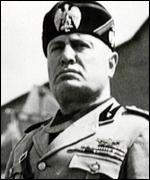 Italian Dictator Benito Mussolini
Italian Dictator Benito Mussolini
Oddly, while the army retreated in disarray, the Emperor seemed toretreat in leisure. He did not retreat with the army, but behind it, adangerous situation that upset some of his advisors as dangerousopening him up for possible capture. The monarch had perhaps given upon earthly powers and was turning to higher authorities. Emperor HaileSelassie paid a secret visit to the churches at Lalibella to pray,taking the time to visit the distant church of Our Lady at the summitof Mt. Asheten as well. This trip was a huge detour that extended hisretreat considerably and dangerously. Finally, the Emperor finished hisprayers and then proceeded out of Wello and on to Addis Ababa. Upon hisarrival an emergency meeting of war leaders and nobles was held at thepalace to decide what the next action should be. It was agreed thatAddis Ababa would be impossible to defend, and that in the interests ofpreserving the Imperial house, the Empress and the Imperial familyshould immediately leave for Djibouti, and board an English ship forPalestine. A debate was held as to what the Emperor himself and thegovernment should do. Some believed that it would be best to relocatethe government to Gore, in the remote south. The Emperor agreed withthis and ordered that it be done immediately. It was then discussedwhether it would be wise for the Emperor to move with the government toGore, and fight on, or leave with his family and present the plea ofthe Ethiopian people in person before the League of Nations in Geneva.One of his long time supporters and fellow modernist, Blatta Takkeleangrily stated that an Ethiopian Emperor had never fled a battle, andthat Emperor Haile Selassie should die in the glory of battle ratherthan go into exile and beg for the help of European colonialists.Ironically, it was the chief voice of conservatism, Ras Kassa Hailu,who just as forcefully argued against this traditionalist positionchampioned by a modernist. The premier prince of the blood argued thatif the Emperor stayed and was killed or captured, the cause of Ethiopiawould be finished as the forces of opposition to the Italiansfragmented. By staying alive and safe abroad, he could appeal forassistance and return some day to fight again, keeping hope alive forthe risistance. The Empress also pulled the Emperor asside and stressedher agreement with this position. She added that he should come withher to Jerusalem and pray for the deliverance of their country withher. Blatta Takelle is said to have horrified the assembled courtiersby threatening to draw his gun and saying that he would rather shootthe Emperor himself rather than have his country abandoned by her king.The Emperor made his decision. On the morning of May 3rd, 1936,TheEmperor with Empress Menen, Crown Prince Asfaw Wossen with CrownPrincess Wollete Israel and Princess Ijigayehu their daughter; PrincessTenagnework and her children, Princesses Aida, Seble,Sophia,Hirut,Princes Amha and Iskinder Desta; Princess Tsehai; PrinceMakonnen Duke of Harrar; and Prince Sahle Selassie; along with numerousnobles and officials boarded the train to Djibouti. Crowds assembled tosee them off, and as the trian pulled out, the crowds began to wail.When news that the Emperor had fled began to spread, panic began to setin. The government had packed up and departed hurriedly for Gore. TheEmperor had appointed his cousin Ras Imiru as Prince-Regent andCommander-in-Chief. Ras Desta Damtew, the Emperor's son-in-law andhusband of Princess Tenagnework was to continue in command of theImperial forces in the south. The remnants of the northern Armies weredirected to join him or Ras Imiru immediately. Dejazmatch Beyene Merid,husband of the Emperor's eldest daughter, Princess Romanework (from hisfirst marriage) remained in command of troops in Bale, under thegeneral command of Ras Desta. Princess Romanework and her two littlesons remained behind with the Dejazmatch rather than go into exile. Thechief of the Addis Ababa police, Balambaras (later Ras)Abebe Aregaibegan to organize a guerrilla army, set fire to key structures that hedidn't want the Italians to seize and marched out of the city. With thedeparture of the Imperial family, the exit of the government and of thearmy, disorder began to take root as the residents realized that thecity was on the verge of falling to the hated Italians. Many began toloot and burn, and foriegn nationals fled to the safety of thecompounds of the various diplomatic missions.
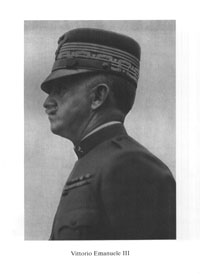 Vittorio Emannuelle III, King of Italy, Proclaimed "Emperor of Ethiopia" by Mussolini
Vittorio Emannuelle III, King of Italy, Proclaimed "Emperor of Ethiopia" by Mussolini
On May 5th, 1936, the armies of Facist Italy, led by Marshal PietroBadoglio marched into Addis Ababa and occupied the city. Promptly, thatvery day, Benito Musollini went out onto the balcony of the VeneziaPalace in Rome and declared that "Ethiopia is Italian" before hugethrongs of cheering Romans. The King of Italy emerged on the balcony asthe dictator proclaimed him Vittorio Emannuelle, King of Italy andEmperor of Ethiopia before the wildly cheering masses. The new"King-Emperor" of the new "Italian Empire" in gratitude bestowed thetitle of "Duke of Addis Ababa" as a hereditary title upon MarshalBadoglio, and Marchese of Neghelli on Marshal Graziani, the commanderof the Ialian troops that seized Harrar. Mussolini appointed Badoglioas the Vice-Roy (Vice-re) in what would henceforth be refered to as"Africa Orientale Italiana" or Italian East Africa, and would combineEthiopia with the Italian colonies of Somaliland and Eritrea. The titleof Niguse Negest (King of Kings) which had been used by the Emperors ofEthiopia was forbiden to be used for the King of Italy. His newImperial title over Ethiopia would be Keasare Ityopia (Caesar ofEthiopia) in an echo of Italian pretentions to ancient empire. TheItalian flag was raised over the palace of Menelik, and the Italiansbegan to set up colonial administration as they continued the militarycampaign to stamp out the resistance in the south.

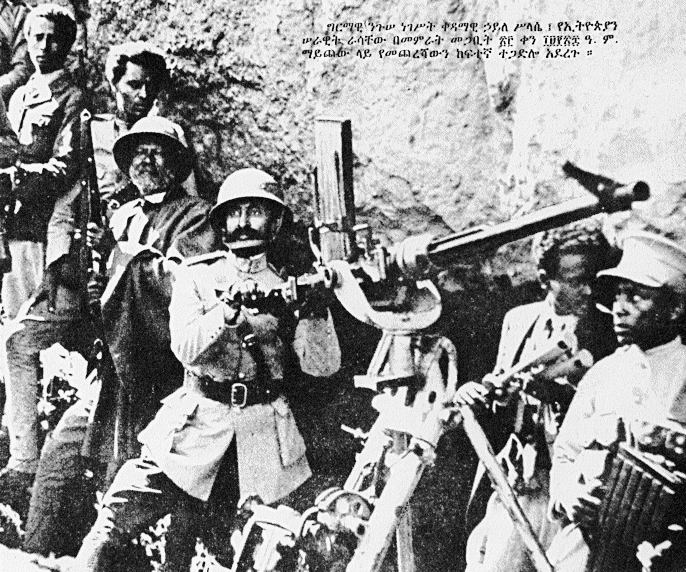 The Emperor mans an anti-aircraft gun during the Battle of Maichew
The Emperor mans an anti-aircraft gun during the Battle of Maichew
 In the mean time, Emperor Haile Selassie and his family were enteringDjibouti. As the Emperor had left, he had ordered two pominentprisoners be brought to him and be put on the train. The Imperial trainhad stopped at Dire Dawa, where the Emperor had these prisoners broughtbefore him. They were Ras Hailu Tekle Haimanot, the disgraced Prince ofGojjam, and Dejazmatch Balcha Saffo, the great general of Adowa andservant of Menelik who had tried to rebel against the then King Taffarion behalf of Empress Zewditu and the conservatives. He addressed theseprisoners by telling them that although he recognized that they did notfavor him, he hoped that their love of their country would guide themin their actions, and he released them. Ras Hailu promptly boarded atrain for Addis Ababa and submitted to the Italian forces. He wouldserve them loyaly for the duration of the occupation, and in return hewas recognized as the senior "native noble". Dejazmatch Balcha howeverwas a man of a different caliber. Although aged and very bitter towardsthe Emperor (whom he continued to contemptuously refer to as Taffari),he retained a strong love of his country, an unshakable loyalty toEmperor Menelik, and a deep hatred of Italy going back to the Adowacampaign. He and a band of followers became guerrilla fighters whoharrassed and made life difficult for the Italian occupiers for monthson end. Finally, when his troops were almost all dead, and he himselfwas exhausted and had little hope of success, Dejazmatch Balcha sent amessage to the local Italian commander near Harrar and announced thathe was prepared to surrender to him and to meet at a specific locale.The officer, accompanied by an appropriate guard in dress uniform wentto recieve the surrender. The found the old Oromo nobleman, wrapped ina traditional white shawl, sitting under a large tree. As theyapproached him, he cried out to "Menelik my master" and pulled out amachine gun, killing all the senior officers before being gunned downhimself. He is upheld as a great hero of the resistance to this day.
In the mean time, Emperor Haile Selassie and his family were enteringDjibouti. As the Emperor had left, he had ordered two pominentprisoners be brought to him and be put on the train. The Imperial trainhad stopped at Dire Dawa, where the Emperor had these prisoners broughtbefore him. They were Ras Hailu Tekle Haimanot, the disgraced Prince ofGojjam, and Dejazmatch Balcha Saffo, the great general of Adowa andservant of Menelik who had tried to rebel against the then King Taffarion behalf of Empress Zewditu and the conservatives. He addressed theseprisoners by telling them that although he recognized that they did notfavor him, he hoped that their love of their country would guide themin their actions, and he released them. Ras Hailu promptly boarded atrain for Addis Ababa and submitted to the Italian forces. He wouldserve them loyaly for the duration of the occupation, and in return hewas recognized as the senior "native noble". Dejazmatch Balcha howeverwas a man of a different caliber. Although aged and very bitter towardsthe Emperor (whom he continued to contemptuously refer to as Taffari),he retained a strong love of his country, an unshakable loyalty toEmperor Menelik, and a deep hatred of Italy going back to the Adowacampaign. He and a band of followers became guerrilla fighters whoharrassed and made life difficult for the Italian occupiers for monthson end. Finally, when his troops were almost all dead, and he himselfwas exhausted and had little hope of success, Dejazmatch Balcha sent amessage to the local Italian commander near Harrar and announced thathe was prepared to surrender to him and to meet at a specific locale.The officer, accompanied by an appropriate guard in dress uniform wentto recieve the surrender. The found the old Oromo nobleman, wrapped ina traditional white shawl, sitting under a large tree. As theyapproached him, he cried out to "Menelik my master" and pulled out amachine gun, killing all the senior officers before being gunned downhimself. He is upheld as a great hero of the resistance to this day.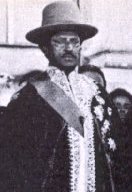 Ras Hailu Tekle Haimanot, Prince of Gojjam
Ras Hailu Tekle Haimanot, Prince of Gojjam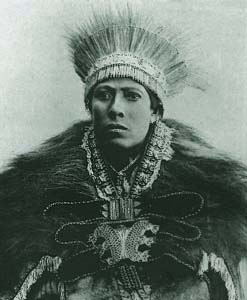 Dejazmatch Balcha Saffo (Abba Nefso)
Dejazmatch Balcha Saffo (Abba Nefso)
 Film exists of the arrival of the Imperial family of Ethiopia and theirretinue at Djibouti. They recieved a state welcome by the FrenchGovernor of the colony. The Empress is shown wearning a large hatcovered by a heavy veil, but eye witness accounts state that she weptthrough the whole proceedings. Two trains had arrived in Djibouticarrying many people into exile with the family. Ethiopians resident inthe French colony lined the roads in Djibouti to see for themselves ifindeed the Imperial family had gone into exile for the first time inhistory. When they saw that it was indeed a somber Haile Selassie, anda weeping Empress, they too were seen to weep according to theIllustrated Times of London. An English ship had been directed to pickup the Emperor of Ethiopia and convey him to Palestine. When the shiparrived, it was determined that not all of the people that had goneinto exile with the Emperor would be allowed to board the ship forPalestine, and when the Imperial family and a small group of followers(about half of those who had arrived on the two trians) boarded theship and set sail, those anguished people left behind stood on thedocks and wailed and wept as the monarch departed. The Emperor relatesin his autobiography how some Ethiopian men and women resident in Egyptrented a boat as his ship passed through Port Said, and sailed next toit waving an Ethiopian flag. When he came out on deck to aknowledgethem, he saw them break down and weep, the incident moved him deeply.The Illustrated Times of London printed photographs of the Imperialcouple arriving at Haifa, the Emperor and Empress looking dejected.They proceeded to Jerusalem to pray, and to settle in while the Emperorprepared to present Ethiopia's case to the League of Nations at Geneva.
Film exists of the arrival of the Imperial family of Ethiopia and theirretinue at Djibouti. They recieved a state welcome by the FrenchGovernor of the colony. The Empress is shown wearning a large hatcovered by a heavy veil, but eye witness accounts state that she weptthrough the whole proceedings. Two trains had arrived in Djibouticarrying many people into exile with the family. Ethiopians resident inthe French colony lined the roads in Djibouti to see for themselves ifindeed the Imperial family had gone into exile for the first time inhistory. When they saw that it was indeed a somber Haile Selassie, anda weeping Empress, they too were seen to weep according to theIllustrated Times of London. An English ship had been directed to pickup the Emperor of Ethiopia and convey him to Palestine. When the shiparrived, it was determined that not all of the people that had goneinto exile with the Emperor would be allowed to board the ship forPalestine, and when the Imperial family and a small group of followers(about half of those who had arrived on the two trians) boarded theship and set sail, those anguished people left behind stood on thedocks and wailed and wept as the monarch departed. The Emperor relatesin his autobiography how some Ethiopian men and women resident in Egyptrented a boat as his ship passed through Port Said, and sailed next toit waving an Ethiopian flag. When he came out on deck to aknowledgethem, he saw them break down and weep, the incident moved him deeply.The Illustrated Times of London printed photographs of the Imperialcouple arriving at Haifa, the Emperor and Empress looking dejected.They proceeded to Jerusalem to pray, and to settle in while the Emperorprepared to present Ethiopia's case to the League of Nations at Geneva.
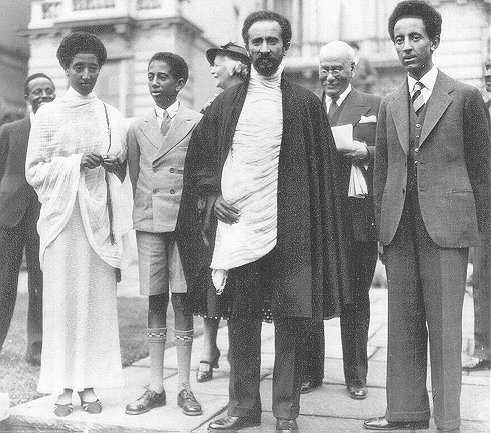 Foreground, left to right, Princess Tsehai, Prince MakonnenDuke of Harrar, His Imperial Majesty the Emperor, Crown Prince AsfawWossen, in London during their exile. Behind the Emperor's leftshoulder is Dr. Workineh Eshete (A.K.A. Charles Martin) EthiopianMinister to the Court of St. James.
Foreground, left to right, Princess Tsehai, Prince MakonnenDuke of Harrar, His Imperial Majesty the Emperor, Crown Prince AsfawWossen, in London during their exile. Behind the Emperor's leftshoulder is Dr. Workineh Eshete (A.K.A. Charles Martin) EthiopianMinister to the Court of St. James.
The Emperor and his entourage were determined to make a stand againstItaly at the League of Nations. Although France and the United Kingdomhad continued to press Ethiopia to accept partition, and now that theItalians had marched into the capital, both these powers were leaningheavily towards recognizing Italian rule over Ethiopia, the Emperor hada strong case to be heard, and they could do little to prevent Ethiopiafrom presenting her case. Many roadblocks were set up though to make itdifficult. The Italians spread rumors that the Imperial family had fledwith tons of gold and silver, that the Emperor had ordered the torchingof Addis Ababa and the butchering of the people. In reality, theEmperor had left to prevent a bloodbath in the city, and he had leftwith little money, although he did take with him his crown and the oldwar tent of Emperor Menelik to prevent it from falling into the handsof the facists. The Emperor arrived in Geneva to address the League ofNations in person. He was the first head of state to appear before theassembly, and the only one who would ever address it. The assembly ofthe League of Nations was being presided over by the Romanian delegate.The gallaries above the floor of the assembly were packed withjournalists, many of whome were Italians. When "His Majesty the Emperorof Ethiopia" was anounced, the Italian journalists in the gallary beganto whistle, stomp their feet and jeer loudly. The Emperor quietlywalked up to the podium and stood quietly, a small man in a black capelooking up at the loudly protesting Italians silently. The angrypresident of the session, the delegate from Romania (who was chairingthe session) lost his temper and demanded that the security personelle"Remove the savages!", and the Italians were removed from thegallaries. The Emperor then began his historic speech. The Emperor,although fluent in French, spoke in Amharic. He traced the history ofthe conflict and the atrocities commited by the Italians. He told ofthe horrors of poison gas attacks and the death rained on his people.He appealed to the League to follow through on it's guarantees ofcollective security, and the promise that small and weak countrieswould not be allowed to be the victims of the large and strong. 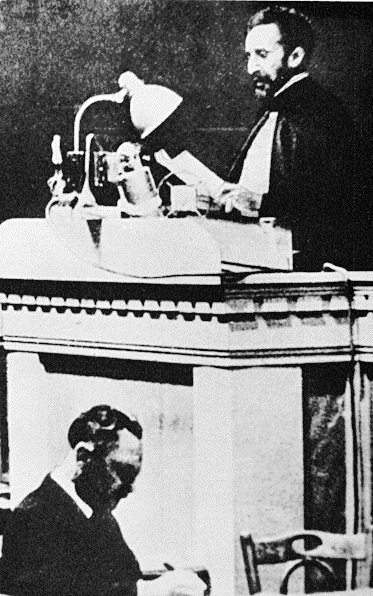 "What answer shall I take back to my people?" He asked the league. Healso said, "It is us today, it will be you tomorrow." Prophetic wordsthat foreshadowed the coming horror of the Second World War. Heconcluded by telling the assembly that "God and History shall rememberyour judgement." It was a historic speech that was applauded around theworld. The Emperor of Ethiopia was toasted and hailed around the worldby anti-facists, and Time magazine named him "Man of the Year".The Emperor addresses the League of Nations, 1936
"What answer shall I take back to my people?" He asked the league. Healso said, "It is us today, it will be you tomorrow." Prophetic wordsthat foreshadowed the coming horror of the Second World War. Heconcluded by telling the assembly that "God and History shall rememberyour judgement." It was a historic speech that was applauded around theworld. The Emperor of Ethiopia was toasted and hailed around the worldby anti-facists, and Time magazine named him "Man of the Year".The Emperor addresses the League of Nations, 1936
In spite of his victory in the battle for public opinion, theLeague of Nations did little however to help the Emperor, beyond weaksymbolic sanctions that had little effect on Italy. Although the Leaguedid recognize the government at Gore, and did not accept the Italianarguement that the Ethiopian Empire ceased to exist due to theirconquest, Great Britain, France and the United States all gaverecognition to the Italian conquest of Ethiopia by aknowledging KingVittorio Emanuele III of Italy as Emperor of Ethiopia. The Leagueaccepted the Emperor's arguement that the Ethiopian governmentcontinued to exist at Gore, and permitted the Ethiopian delegation tocontinue to sit in the League and represent that government. TheEmperor departed for Britain to begin his new life in exile. He wasassisted in his work by Lorenzo Taezaz, and Eritrean born loyalist whoacted as his primary representative to the Leage and a frequent gobetween with exiles and resistance fighters. Azaj Workineh Eshete (Dr.Charles Martin), the Ethiopian minister to Great Britain was also anactive participant in raising funds and publicity for the cause ofEthiopia. Blatangueta Hirui, the elderly foriegn minister of Ethiopiaworked also towards liberation from exile, until his death in London in1937.
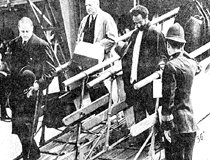 The Emperor disembarks at Southampton, to begin his English Exile
The Emperor disembarks at Southampton, to begin his English Exile
 Back in Ethiopia the Italians were settling in. The Italians tookposession of the capital and set about building the foundations fortheir new administration. The former colonies of Eritrea and ItalianSomaliland were merged with Ethiopia to form what they called "AfricaOrientale Italiana" or "AOI", a single colony ruled from Addis Ababa bythe Vice-Roy as the representative of the King-Emperor(Kesare) and theDuce Mussollini. As administative units, the Empire was restructuredinto new regions that replaced the old Imperial provinces. The Ogadenwas joined to Italian Somaliland and made the new governorate of"Somali" based in Mogadishu in the east, the southern kingdoms,provinces and principalities became the governorate of "Galla-Sidamo"and was ruled from Jimma. In the north, Tigrai and Eritrea were mergedinto the governorate of "Eritrea" based in Asmara, Gojjam, Beghemidirand Simien, Wello and parts of northern Shewa were merged into thegovernorate of "Amhara" based in Gondar. The region surrounding AddisAbaba was first named after the capital, but later was re-named thegovernortate of "Shewa" and was ruled directly by the Vice-Roy. Harrarand Dire Dawa, and their environs became the "Harrar governortate". TheVice-Roy took up residence in the Emperor's Guenete Leul Palace. AddisAbaba was divided between the "Native" and "Colonial" districts. Thecity market, once next to the Cathedral of St. George was moved furtherout and named "Merkato Indigino" and is still refered to as "Merkato"today. This was the "native" district of the city. Italian names weregiven different parts of the City. The city center of the time wasnamed Piazza (which it is still refered to as even today), the CasaPopulare and Casa I.C.E.S. are even today refered to as Populare andCasanchis districts of the capital. The Italians would build newbuildings and roads, further modernizing the city of Addis Ababa, andthe ancient towns of Gondar and Jimma were to be similarly developed bythe Italians. Although the Facists ordered strict racial segregationand non-fraternization, this policy was not agressively enforced. TheItalian soldiers and officers, and later settlers, formed friendshipsand romantic liasons, and had children with Ethiopians, relationshipsthat would survive the occupation. For this reason, many would remainin Ethiopia after the occupation was over. However, the Fascistdoctrine of conquest was based on an ideology of revenge for thehumiliation of Adowa, and the erasing of Ethiopian national identity.The Italians looted what they could of Ethiopia's heritage. Severalcrowns of previous monarchs were taken to Italy on Mussolini's orders.Badoglio showed one crown to the English writer Evlyn Waugh (a fascistsympathizer) to confirm that this was in fact the crown of EmperorHaile Sellassie, whose coronation Waugh had attended five yearsearlier. Waugh confirmed that the silver gilt crown was indeed thecrown of Emperor Haile Sellassie, but he was mistaken. The crown usedat the coronation in 1930 was solid gold, not silver gilt, and hadaccompanied the Imperial family into exile. The Italians carried offthe taller of the two standing obelisks at Axum, and erected it in Romein front of the Ministry of the Colonies (the headquarters for theUnited Nations Food and Agricultural Organization today) where it stillstands. During the visit to Addis Ababa by the Minister for theColonies, Lessona, he ordered several other monuments removed also.Taken to Rome was the Lion of Judah monument from in front of the AddisAbaba train station. The lion was re-erected in Rome next to theVittorio Emanuelle monument. The Italians also removed the statue ofEmperor Menelik from the square in front of St. George's Cathedral andalso the crown from the top of the dome of the Ba'eta monastery whereMenelik II was buried. These two large monuments of the Ethiopianmonarchy were removed in the dead of night, and taken out of the cityand hidden. The next morning, people came out into the streets of thecity and saw the empty pedestal of the statue of Emperor Menelik, andmany are said to have beaten their chests and wept as if at atraditional Ethiopian funeral. The Italians took a host of valuableworks of art, manuscripts, and the entire Imperial archives and tookthem to Italy. After a few months as the Vice-Roy of the "King-EmperorVittorio Emanuelle III", Marshal Badoglio, "Duke of Addis Ababa"resigned and returned to Rome, where he could better bask in the gloryof being the conqueror of Italy's new Empire. More of a monarchist thana staunch fascist, he found himself in constant battles with theMinister for the Colonies, Lessona, over ideological and jurisdictionalissues. He was replaced as Vice-Roy by Marshal Graziani, a staunchfascist, and a man with a bloody reputation from his ruthlesssupression of rebles in Italian ruled Libya. Although the Italians hadproclaimed a new "Fascist Empire", Ethiopia was hardly conquered andpacified. Wide stretches of the countryside remained outside Italiancontrol, and would remain so for the duration of the occupation.Although all the major urban areas were firmly occupied, rural areasremained restive and alive with anti-Fascist activity. The armys of RasImiru and Ras Desta remained in the south, very actively opposing theItalians. Guerillas were banding together in the central and northernhighlands as well. In particular, Abebe Arregai in Shewa, Belai Zellekein Gojjam, and "Amoraw (The Hawk)" Wubineh in Beghemidir led wellorganized guerilla forces that harrassed and bloodied the Italiansagain and again, making it impossible for them to ever fully extendFascist rule.
Back in Ethiopia the Italians were settling in. The Italians tookposession of the capital and set about building the foundations fortheir new administration. The former colonies of Eritrea and ItalianSomaliland were merged with Ethiopia to form what they called "AfricaOrientale Italiana" or "AOI", a single colony ruled from Addis Ababa bythe Vice-Roy as the representative of the King-Emperor(Kesare) and theDuce Mussollini. As administative units, the Empire was restructuredinto new regions that replaced the old Imperial provinces. The Ogadenwas joined to Italian Somaliland and made the new governorate of"Somali" based in Mogadishu in the east, the southern kingdoms,provinces and principalities became the governorate of "Galla-Sidamo"and was ruled from Jimma. In the north, Tigrai and Eritrea were mergedinto the governorate of "Eritrea" based in Asmara, Gojjam, Beghemidirand Simien, Wello and parts of northern Shewa were merged into thegovernorate of "Amhara" based in Gondar. The region surrounding AddisAbaba was first named after the capital, but later was re-named thegovernortate of "Shewa" and was ruled directly by the Vice-Roy. Harrarand Dire Dawa, and their environs became the "Harrar governortate". TheVice-Roy took up residence in the Emperor's Guenete Leul Palace. AddisAbaba was divided between the "Native" and "Colonial" districts. Thecity market, once next to the Cathedral of St. George was moved furtherout and named "Merkato Indigino" and is still refered to as "Merkato"today. This was the "native" district of the city. Italian names weregiven different parts of the City. The city center of the time wasnamed Piazza (which it is still refered to as even today), the CasaPopulare and Casa I.C.E.S. are even today refered to as Populare andCasanchis districts of the capital. The Italians would build newbuildings and roads, further modernizing the city of Addis Ababa, andthe ancient towns of Gondar and Jimma were to be similarly developed bythe Italians. Although the Facists ordered strict racial segregationand non-fraternization, this policy was not agressively enforced. TheItalian soldiers and officers, and later settlers, formed friendshipsand romantic liasons, and had children with Ethiopians, relationshipsthat would survive the occupation. For this reason, many would remainin Ethiopia after the occupation was over. However, the Fascistdoctrine of conquest was based on an ideology of revenge for thehumiliation of Adowa, and the erasing of Ethiopian national identity.The Italians looted what they could of Ethiopia's heritage. Severalcrowns of previous monarchs were taken to Italy on Mussolini's orders.Badoglio showed one crown to the English writer Evlyn Waugh (a fascistsympathizer) to confirm that this was in fact the crown of EmperorHaile Sellassie, whose coronation Waugh had attended five yearsearlier. Waugh confirmed that the silver gilt crown was indeed thecrown of Emperor Haile Sellassie, but he was mistaken. The crown usedat the coronation in 1930 was solid gold, not silver gilt, and hadaccompanied the Imperial family into exile. The Italians carried offthe taller of the two standing obelisks at Axum, and erected it in Romein front of the Ministry of the Colonies (the headquarters for theUnited Nations Food and Agricultural Organization today) where it stillstands. During the visit to Addis Ababa by the Minister for theColonies, Lessona, he ordered several other monuments removed also.Taken to Rome was the Lion of Judah monument from in front of the AddisAbaba train station. The lion was re-erected in Rome next to theVittorio Emanuelle monument. The Italians also removed the statue ofEmperor Menelik from the square in front of St. George's Cathedral andalso the crown from the top of the dome of the Ba'eta monastery whereMenelik II was buried. These two large monuments of the Ethiopianmonarchy were removed in the dead of night, and taken out of the cityand hidden. The next morning, people came out into the streets of thecity and saw the empty pedestal of the statue of Emperor Menelik, andmany are said to have beaten their chests and wept as if at atraditional Ethiopian funeral. The Italians took a host of valuableworks of art, manuscripts, and the entire Imperial archives and tookthem to Italy. After a few months as the Vice-Roy of the "King-EmperorVittorio Emanuelle III", Marshal Badoglio, "Duke of Addis Ababa"resigned and returned to Rome, where he could better bask in the gloryof being the conqueror of Italy's new Empire. More of a monarchist thana staunch fascist, he found himself in constant battles with theMinister for the Colonies, Lessona, over ideological and jurisdictionalissues. He was replaced as Vice-Roy by Marshal Graziani, a staunchfascist, and a man with a bloody reputation from his ruthlesssupression of rebles in Italian ruled Libya. Although the Italians hadproclaimed a new "Fascist Empire", Ethiopia was hardly conquered andpacified. Wide stretches of the countryside remained outside Italiancontrol, and would remain so for the duration of the occupation.Although all the major urban areas were firmly occupied, rural areasremained restive and alive with anti-Fascist activity. The armys of RasImiru and Ras Desta remained in the south, very actively opposing theItalians. Guerillas were banding together in the central and northernhighlands as well. In particular, Abebe Arregai in Shewa, Belai Zellekein Gojjam, and "Amoraw (The Hawk)" Wubineh in Beghemidir led wellorganized guerilla forces that harrassed and bloodied the Italiansagain and again, making it impossible for them to ever fully extendFascist rule.
Remnants of the Imperial army however were determined to oust theItalians from Addis Ababa. The scattered brigades needed someone tolead them, and coordinate with the guerillas. Soon, the rumors sweptthrough Addis Ababa, that the Imperial red umbrella's had been seen inMenz to the north. The House of Solomon was far from finished. In Menz,the sons of the premier prince of the blood, Ras Kassa Hailu, wererallying the peasantry to the banner of the dynasty. DejazmatchWondwossen Kassa, Dejazmatch Abera Kassa, and Dejazmatch Asfaw WossenKassa began to gather the remnants of the Imperial forces and many morepeasants urban intelegencia who had fled the occupation of the citiesinto a new army. With them was the Bishop of Wello, Abune Petroshimself, who rallied the population and exhorted them to refuse therule of the enemy. The three royal Dejazmatches captured theimagination of the Shewan loyalists of the dynasty, and plans were setup to expell the Italians from Addis Ababa.
TO BE CONTINUED......
Click Here to Continue with Part IIIof History and PicturesBack to Imperial Ethiopia Homepage
